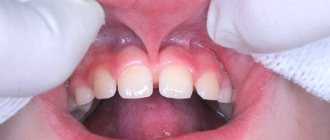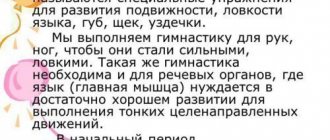The frenulum of the tongue performs important functions, among which are ensuring correct pronunciation, maintaining the health of the mucous membranes, maintaining the facial muscles, and participating in the formation of the bite. Sometimes, in order to restore all these functions, it is necessary to perform surgical plastic surgery of the organ. This procedure is not particularly difficult and is performed mainly in childhood. However, it is not uncommon for adult patients to need correction of the shape of the tongue frenulum.
What is lingual frenuloplasty?
The frenulum is a small membrane that connects the lower part of the tongue and the mucous membrane of the lower jaw. Despite its small size, it performs very important functions: it is responsible for the formation of dental occlusion, controls the mobility of the tongue and the functioning of the facial muscles.
There are three main pathologies of the tongue frenulum that require surgical correction.
- Wrong shape.
A healthy frenulum is a fold of mucous membrane in the shape of an arc. - Small size
(in medical terminology - ankyloglossia). The average length of the frenulum of the tongue in an adult is 3 centimeters; in a child it is shorter. In the case of ankyloglossia, the frenulum will not allow the tongue to be raised completely upward. - Incorrect mounting location.
A healthy frenulum is attached to the middle of the tongue, and with pathology it can be shifted to the tip.
In some cases, it becomes necessary to perform plastic surgery of the lip frenulum - the fold of mucous membrane connecting the lip and gum. The operation is performed to avoid impaired diction and the formation of malocclusion. Read more about lip frenuloplasty here.
How to trim the frenulum under the tongue?
Trimming the short frenulum of the tongue is as follows:
- Local anesthesia
- Excision of a shortened frenulum
- Trimming the mucous membrane adjacent to the frenulum and moving it
- Suturing of the mucous membrane (when performing laser surgery, the operation is seamless)
In children, stretching the frenulum does not cause any problems. After just a couple of hours, the baby can be put to the breast. In adults, surgery is followed by a short recovery period.
Causes of tongue frenulum anomaly
Most children have mild pathology, but severe forms are also not uncommon. The size of a child’s tongue frenulum is most often determined by heredity, as well as the following factors:
- viral infection in the mother in the first and last trimesters;
- late toxicosis;
- exacerbation of chronic diseases during pregnancy;
- injuries in the abdominal area during gestation;
- taking potent drugs by the expectant mother.
Symptoms of a shortened frenulum
How to determine if your baby needs surgery? It is necessary to seek specialist advice. However, you can notice signs of a defect in the frenulum of the tongue yourself by paying attention to some details.
- The frenulum resembles a transparent film and does not have a vascular network.
- The tongue is inactive.
- The child cannot reach the upper palate with the tip of his tongue.
- When you move your tongue, clicks are heard.
- Chewing and swallowing are difficult.
- Diction is broken.
- The lower front teeth are turned towards the tongue.
How to understand whether a tongue frenulum is short or not?
Determining frenulum shortening is quite simple even in newborns. Their feeding process is disrupted and weight loss may occur. But in some cases, incorrect attachment of the frenulum is detected in an adult.
| Signs of a shortened frenulum | Indications for surgery |
| • Restricted mobility of the tip of the tongue • The tongue curls into a tube with a clicking sound • Impaired pronunciation of certain sounds | • Quick tiredness of the mouth when chewing and talking • The area under the tongue hurts when it moves too sharply • Malocclusion • Displacement of the gums • Curvature of the smile, violation of facial proportions • Disturbance of normal breathing |
Specialists at the Smile clinic will conduct a comprehensive examination of the client and determine whether there are indications for surgery, eliminating contraindications. Doctors guarantee the safety of patients and take care of their comfort.
When and who needs tongue frenuloplasty?
Most often, an abnormality of the frenulum of the tongue can be diagnosed in a child immediately after birth. Then it is recommended to fix it. However, plastic surgery is performed on children of preschool and school age, as well as adults. The operation is indicated in the following cases.
- Violation of sucking in newborns.
If babies have a tongue frenulum that is too short, they cannot latch onto the nipple properly, resulting in underweight, fussiness, and poor sleep. - Diction defects.
Due to poor tongue mobility, children distort some sounds, especially “r”, “l” and hissing sounds. As a rule, the problem is discovered by a speech therapist in preschool age. - Abnormal shape of teeth and gums.
A tongue frenulum that is too short can interfere with proper growth of the lower jaw. This leads to incorrect positioning of the front teeth and gum recession. - Preparation for implantation and prosthetics.
Any deviations in the shape of the soft tissue from the norm can ultimately lead to implant failure, so they need to be corrected before surgery. The discomfort caused by the pathology of the frenulum of the tongue during the use of removable dentures, especially on the lower jaw, is also important: the structures simply fall out when talking or eating.
What happens if tongue frenuloplasty is not performed in children?
An abnormality of the frenulum of the tongue in children provokes the following serious consequences.
- Due to a violation of the sucking regime in infancy, the child may not receive enough nutrition and, as a result, lag behind in development.
- Children with tongue frenulum abnormalities may never learn to pronounce some sounds.
- Incorrect placement of the frenulum leads to underdevelopment of the lower jaw, resulting in the formation of an incorrect bite.
If pathology of the frenulum of the tongue has been identified in a newborn, it can be easily corrected by making an incision with a laser. At this age, you won't even need stitches. With age, the structure of the frenulum becomes more complex, new vessels appear in it, so plastic surgery of the frenulum in preschool and school-age children turns into a full-fledged surgical operation. Therefore, it is best to do it at the age of 5-6 years, when the child’s milk teeth are replaced by permanent ones.
Parents can determine whether their child needs surgery on their own. To do this, ask him to reach the upper palate with the tip of his tongue. If he cannot do this, or it hurts, he should consult a doctor.
Table of contents
- For what reason does a frenulum defect form?
- Symptoms of congenital frenulum pathology
- Types of frenulum pathology
- Complications with frenulum defects
- How is a frenulum defect treated?
It is due to the presence of the lingual frenulum that a person has the ability to consume food, influence breathing and even control the tongue to speak. It is worth noting that problems often arise with the lingual ligament, since its structure is of considerable importance.
- Ideally, the membrane in the oral cavity should be approximately 3 cm in an adult, and at least 8 mm in children, which will be considered normal.
- The frenulum may vary from person to person in length, density, and degree of elasticity.
- If the structure of the ligament is correct, then it will not affect the mobility of the baby’s tongue.
For what reason does a frenulum defect form?
Dentists call frenulum pathology a congenital defect, which depends on several factors.
- Genetic inheritance. According to statistics, if one parent had a similar problem, then the probability of it occurring in the child is 50%.
- Violation of fetal development during the perinatal period. In other words, a congenital defect of the frenulum appears, which leads to abnormal cords, or in other words, the formation of connective tissues well supplied with blood fluid, which prevents the child from properly controlling the tongue.
There are a number of predisposing factors that can lead to such a defect.
- The emergence of the virus in the mother’s body during pregnancy, especially before childbirth.
- Impact of bad environment.
- Pregnancy after 35 years of age.
- Presence of intrauterine infection of the fetus.
- Presence of chronic somatic diseases.
- The occurrence of traumatic injury to the abdominal cavity before pregnancy.
Symptoms of congenital frenulum pathology
In order to diagnose pathology in the development of the frenulum and give indications for correction, you will need not only an examination by a dentist, but also the presence of obvious signs of such a problem. Namely:
- inability to move the tongue outside of the abnormal location;
- the presence of a bifurcation of the tip of the tongue, as well as the shape of the tongue in the form of a cup or groove, due to the fact that its base is tightly pressed to the bottom of the mouth;
- inability to lift and extend the tongue forward;
- touching the lips with the tongue only with its tip;
- the presence of a thin thread between the tongue and the base of the oral cavity when examining a baby.
Types of frenulum pathology
The frenulum defect can be partial or complete. The differences lie in the symptomatic picture.
In the first case, the ligament under the tongue is partially attached to the edge of the bone bed of the dental structure, and in appearance resembles an avascular transparent thin film. In this case, incomplete mobility of the tongue is diagnosed.
In the second case, the tongue is completely immobilized, since its entire length is chained to the base of the mouth. The lips are pressed very tightly against the teeth, and when examined by a specialist, the baby can roll his tongue into a tube, but inside the mouth, without pulling it out.
Complications with frenulum defects
Important: If the pathology of the frenulum is not corrected, then serious consequences are quite possible, which are much more difficult to eliminate.
- A slowdown in the development of the lower jaw and all adjacent bones becomes noticeable.
- An abnormal bite often occurs, in other words, an uneven dentition. There are two options - either too large gaps will form between the teeth, or vice versa - they will begin to move too tightly, which will cause distortion of their location.
Infants who have this pathology often have problems with breastfeeding.
- Due to the lack of full control of the tongue, a child from birth cannot consume breast milk, since he physically cannot grasp the nipple.
- During the feeding process, milk production in the mother's breast will not be stimulated.
- Due to a violation of the sucking function, feeding can be carried out for a long time, but this does not allow obtaining the required amount of milk and, as a result, the child has to be supplemented with artificial nutrition.
- Due to all of the above points, the child begins to develop a fear of feeding and manifests itself in the form of anxiety when hunger occurs. That is why experts recommend switching children completely to artificial nutrition.
If there are problems with the frenulum, nutrition is disrupted because:
- difficulty chewing food;
- difficulty swallowing foods;
- Inflammatory processes in the oral cavity can often occur, which occurs due to increased sensitivity of the mucous membrane.
The most serious consequence is considered to be speech impairment.
- When the time comes for gradual speech training, minor defects may be observed.
- Diction and word formation may be impaired, and even a lisp may be present.
- The child is unable to pronounce the upper lingual sound correctly.
- Problems appear at the age of 2-3 years.
- Maybe personal discomfort when talking, which leads to more silence from the child rather than communication.
Important: If you find such problems, you should immediately contact a specialist to eliminate it as early as possible.
How is a frenulum defect treated?
Doctors may use conservative treatment, which requires the use of articulation exercises. In some cases, this helps avoid surgery. The technique consists of stretching and training the articulatory apparatus.
In extreme cases, surgical correction or, in other words, frenulotomy is performed. This method is used if the defect causes serious problems for the baby. If the frenulum defect is partial, then it is simply trimmed a little, and if you have to deal with complete fusion of the tongue and oral cavity, then a serious operation is needed. During the procedure, the gums and lips are separated from each other, just like the lips are separated from the tongue.
Correction of the ligament under the tongue in newborns is required when:
- identifying problems with breastfeeding, for which plastic surgery of the congenital anomaly is performed by slightly cutting the frenulum;
- the absence of blood vessels and nerve endings in the frenulum under the tongue, which requires cutting the lingual ligament, and if the ligament has partially grown in, then the procedure will not cause problems and does not take much time to carry out;
- If a defect is identified immediately after birth, the procedure is carried out through the use of special dental scissors, which are used to trim the ligament in the first minutes of life, and to stop bleeding it is enough to simply apply it to the chest;
- detecting a problem in the first year of life, for which dental scissors or a radio wave scalpel are also used, with the additional use of local anesthesia.
In general, under the age of one year, the procedure will not take more than a few minutes, and complications do not arise after it. As a rule, after cutting the frenulum immediately after birth, improvements in breastfeeding are noticeable.
Correction of the lingual ligament during the period before school is carried out in a special way and with the presence of specific indicators
- At 2-3 years, a change occurs in the structure of the frenulum, as vessels begin to form in it. The ligament thickens and becomes fleshy. That is why frenuloplasty is performed under anesthesia, in a hospital, and it is necessary to apply sutures that will dissolve on their own.
- If a shortened frenulum is detected in a preschooler due to incorrect sound pronunciation, then this is organic dilalia, and not undergoing correction will lead to inaccurate diction in the future.
Important: In any case, if defects occur with the frenulum under the tongue, you should consult a dentist and speech therapist. This will help solve the problem at an early stage and avoid the serious consequences described earlier. The treatment is carried out without difficulty, quickly and efficiently, which eliminates the occurrence of stress in the child, regardless of his age category.
There is a type of correction through bloodless plastic surgery of the lingual ligament. The method appeared relatively recently, but is already very popular. The essence of the correction is:
- the absence of a detrimental effect on the general condition of the child during frenolotomy;
- carrying out the operation using a special laser device that does not cause discomfort;
- using not anesthesia, but an anesthetic in the form of a gel;
- easier postoperative period, unlike other methods of cutting the ligament, regardless of age and complexity of the problem.
Important: remember that the sooner the procedure is performed, the greater the likelihood of avoiding speech defects and other problems that can cause a lot of harm in adult life. The presence of incorrect diction and incorrect pronunciation of sounds has a very negative impact on learning, communication and even finding a suitable job.
For school-age children who have identified a problem such as pathology of the frenulum under the tongue, radical measures must be taken.
- In advanced cases, after the age of 5 years, frenuplasty must be performed as prescribed by the dentist, or in other words, a serious surgical intervention under general anesthesia, with sutures. If there are severe restrictions in the excursion of the tongue, as well as pronounced complications, for example, advanced pathology, the orthodontist or speech therapist will refer the child to a dental surgeon. The result of the procedure is the release of the tongue, but a properly observed rehabilitation period is required to eliminate the possibility of complications. In some cases, it may be necessary to correct uneven teeth.
- Surgery may be required for an adult with severe periodontal disease and speech defects.
- It is mandatory for children to visit a speech therapist so that speech can be corrected directly, since after the intervention of a doctor, speech normalization does not occur on its own.
Important: The presence of a short frenulum in a child is a serious problem that must be dealt with immediately, not by independent actions, but with the help of qualified specialists. According to statistics, those children whose frenulum was corrected in infancy are the best at restoring speech and getting rid of speech defects. Proper classes with a speech therapist help to completely eliminate the defect, but the participation of parents in the development of the child and, especially, correctional procedures is imperative.
Operation techniques
There are two methods of performing tongue frenuloplasty: traditional (classical) and laser. This is a more modern and safer method. The laser allows the operation to be performed with great precision and does not cause bleeding after the procedure. In addition, there is no need for stitches, and healing time is significantly reduced. This is especially important if you need to perform laser frenuloplasty on a child: the baby will tolerate the procedure much easier.
Depending on what pathology of the frenulum is detected, the doctor uses one of three techniques: cuts the frenulum, removes it, or changes the attachment site. The number of cuts and their shape depend on the choice of technique.
Rehabilitation period
Recovery after the procedure takes 3-4 days, and even less when working with a laser. Recommendations during the rehabilitation period:
- Refusal to eat for 2-3 hours after the procedure
- Avoiding hot, spicy, sour foods for several days
- Avoiding hot drinks for a day
- Limiting solid foods while healing
- Rinsing the mouth with antiseptics
- Using healing ointments
The doctor gives detailed recommendations and prescriptions on an individual basis.
Therapeutic exercises
There are alternative methods that allow you to do without surgery, for example, a set of special exercises for developing the frenulum of the tongue.
- Reach alternately to the upper and lower lips.
- Extend your tongue and make pendulum movements from cheek to cheek.
- Suck your tongue to the roof of your mouth and let go, imitating a horse clopping its hooves.
- Place your tongue on each cheek with your mouth closed.
- Smile with your mouth open.
- Stretch your lips.
- Pull your lips into a tube, pretending to kiss.
To achieve results, you need to perform the exercises every day for 5 - 10 minutes. It is important to remember that this method is suitable for correcting mild disorders; more severe pathologies require surgical intervention.
After operation
As a rule, there are no complications after trimming the frenulum of the upper, lower lip or tongue, and recovery takes only a few days. When the operation is performed, it is best to feed the baby immediately, since mother's milk acts as a pain reliever. Adult patients should temporarily avoid hard and sticky foods. If there are problems with speech, then special sessions with a speech therapist are necessary. The slight discomfort caused by the sutures will go away on its own after they are absorbed, that is, after 4-5 days, maximum in a couple of weeks.
Price for plastic frenulum of the tongue
The cost of this procedure usually consists of the cost of consultation and examination, local anesthesia and the service itself. This is a fairly simple surgical procedure, so no additional tests are required. The price of a classic operation (with a scalpel) for adults and children is the same, but may be slightly higher if the patient has too dense frenulum tissue. Then they do not give local anesthesia, but general anesthesia; it costs more, and, accordingly, costs increase due to this. The average cost of classic lingual frenuloplasty in Moscow is 3,800 rubles. The price for laser plastic surgery of the frenulum of the tongue is about 5,000 rubles.
Consultation with an anesthesiologist
Before the operation, a consultation with an anesthesiologist is required, where the doctor examines the test results and explains how anesthesia will be administered. For children's anesthesia, the safest modern drug, Sevoran, is used, which will be administered through a mask. The anesthesiologist and anesthesiological nurse monitor the condition of the little patient throughout the entire operation, monitoring all vital signs using equipment. The clinic has a postoperative ward, where the child rests for some time after the operation under anesthesia. After being examined by an anesthesiologist, you can go home.
According to the tests, there were no contraindications for treating the child under anesthesia, so the date for the operation was set.









